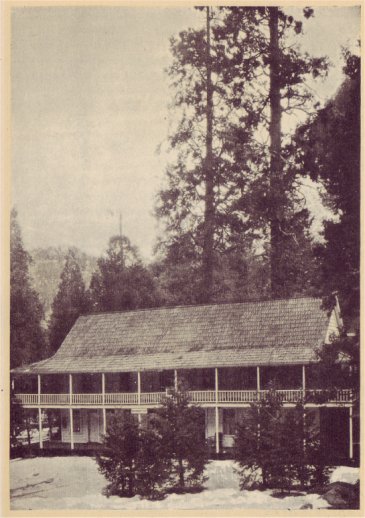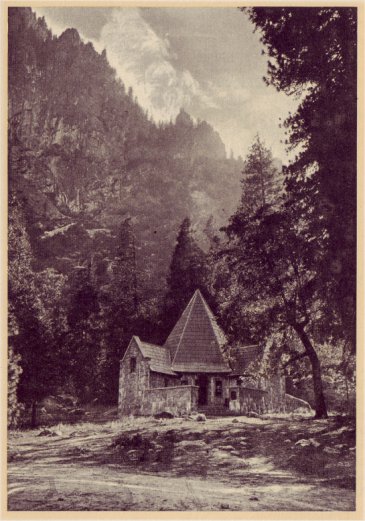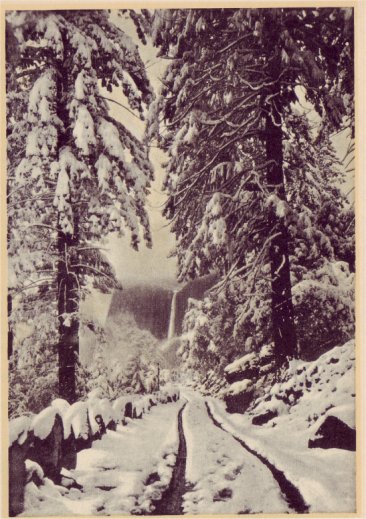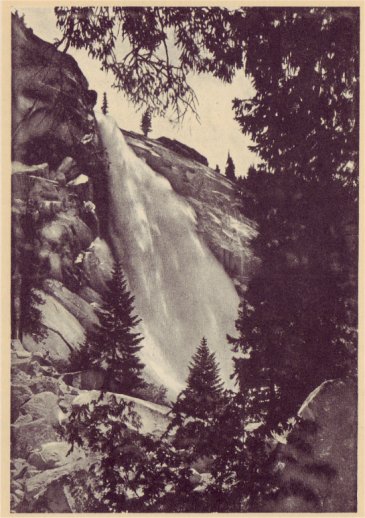
Cedar Cottage, in Old Yosemite Village, the first permanent structure in Yosemite, is known for its Big Tree Room
| Online Library: | Title | Author | California | Geology | History | Indians | Muir | Mountaineering | Nature | Management |
Yosemite > Library > Lights & Shadows > Old Landmarks >
Next: Yosemite Valley • Contents • Previous: Early Travelers
Even in its earliest days, business enterprise was great in Yosemite Valley. Foreseeing another “gold rush” in California, in the tourists certain to flock to Yosemite, two men built inns in the wilderness less than three years after Hutchings’ first trip there. True, the first of these was a saloon, built in the fall of the year of 1856, and opened the next spring to accommodate that class of visitors who must have their whisky and gambling even in the shadow of El Capitan. The following year it was fitted up and used as a restaurant, as it became evident that it was as necessary to eat as to drink, while in Yosemite. Several years later it was enlarged and was known as Black’s Hotel, where John Muir lived many years later after his rupture with Hutchings.
The second of these inns was to become more widely known. It was primarily a blue canvas building erected by a Mr. Beardsly, and later torn down to make way for a wooden structure, which H. M. Hutchings bought. After a few years this became one of the famous hostelries of Yosemite, as distinct a Yosemite landmark of its day as the Sentinel Hotel, Yosemite Lodge, and Camp Curry were to become later. It was called Hutchings’ House and achieved its distinction largely through the personality of its genial host. Certainly it had not many material comforts to recommend it. Owing to its flimsy construction and lack of partitions, at first, the men were all herded downstairs and the women upstairs. Later, paper partitions were erected between rooms, curtains hung for doors, and husbands and wives were permitted to occupy the same apartment. The whisper which was heard around the world would have been quite deafening there, and the shadows on the paper walls must have made lively pantomimes. Nevertheless, these little discomforts were taken good-naturedly by the guests, for the most part, and laughed off as the shortcomings of a poetic host, who would recite poetry as he fetched the morning hot cakes.
A part of the old Hutchings House still stands, on the premises of the Sentinel Hotel, and is known today as Cedar Cottage, because

PHOTO BY GEO. E. STONE
[click to enlarge]
Cedar Cottage, in Old Yosemite Village, the first permanent structure in Yosemite, is known for its Big Tree Room |
Leidig’s Hotel, at the foot of Sentinel Rock, was another favorite inn of its day. The old Stoneman House, in the meadows of the upper part of the Valley, was the most pretentious of them all until it was destroyed by fire. Perhaps one of the most welcome but financially least successful was Snow’s House, which flourished for a few years at the foot of Nevada Falls. All were crude enough, according to report, yet in all a spirit of hospitality and true bonhomie prevailed.
The problem of transporting people into the Valley in those early days was commensurate only with the problem of feeding and sheltering them while they were there. That was no mean undertaking, considering the inaccessibility of supplies. These earlier hotels, then, were comparable, no doubt, to the rude but ample accommodations to be found today in the upper reaches of Yosemite Park, at the Hikers’ Camps at Merced, Booth, and Tenaya Lakes. Shelter, food, beds, and blankets were all that could be provided for the tourist in those days.
One of the show places in the Park was John Smith’s Cosmopolitan House. Its exterior was simple enough, but its interior contained baths! Real bathtubs, with hot and cold water! It also comprised a barber shop, a billiards and pool hall, as well as a reading and writing room. It was the popular rendezvous of the Valley, and in its huge old registry book, divided according to States, are to be found many autographs of people famed in America and abroad. To achieve this oasis on the heights, John Smith, the popular proprietor, had had the foresight and the energy to pack in on mule back, for a distance of fifty miles, all the furnishings for his hotel. These included the bathtubs, full-length mirrors, elaborate glass goblets, and an amazing array of other articles. Such a nature as his might have realized that dream of George Anderson’s had he lived a little longer, a hotel on the shoulder of Half Dome! As this is written, his building still stands in the old Yosemite Village, it being used now

PHOTO BY ANSEL ADAMS
[click to enlarge]
Le Conte Memorial Lodge, built by the Sierra Club, in Yosemite Valley, to preserve lore of the park |
The Sentinel Hotel, of all the old landmarks, is probably the best known and loved by this generation. Outgrown by the changing times, on the score of sentiment it will be missed by many when torn down. Every year guests come into the Valley and want to stop again at the Sentinel Hotel, where they stopped ten, twenty, even forty years ago.
When the State of California re-ceded Yosemite to the United States Government in 1890 to become a National Park, a barracks was erected on the site of the present Lodge to care for the troops who patrolled the Park prior to the creation of the National Park Service. National Parks were at first administered by the War Department. With the recall of the soldiers, and the establishment of the National Park ranger service, the barracks was converted into another summer camp, which was purchased by the Yosemite National Park Company and rebuilt as the present Yosemite Lodge.
At the other end of the Valley, just below Glacier Point, lies Camp Curry, synonymous to many with Yosemite Valley itself. Certainly it is unique among the camps of its kind in America, if not in the world. In 1899 David A. Curry and his wife opened their first camp there, pitching seven tents about a central camp fire, to entertain a party of school-teachers. When the season closed the number of tents had increased to twenty-three and 290 guests had been entertained. As in the earlier hotels of Yosemite, Mr. and Mrs. Curry were true host and hostess to their guests, even when their number grew to such dimensions that it was impossible to know them personally. It was Mr. Curry who originated that most famous of all Yosemite customs, the evening fire-fall from Glacier Point, and his “stentor” call of farewell to the departing guests, and the sentiment it evoked, will long live in tradition.
James C. Lamon was first permanent settler in Yosemite. He is interesting chiefly because he belonged to that great Order of Firsts.

PHOTO BY BEST STUDIO
[click to enlarge]
Tenaya Lake, surrounded by granite domes, carved and polished by glaciers |
Lamon lived in the Valley for fourteen years, and when he died there, he was laid to rest in the little Yosemite cemetery, now in the good-fellowship of Galen Clark, H. M. Hutchings, and other Yosemite pioneers.
Just across the meadows from the Sentinel Hotel, commanding a fine view of Yosemite Falls, is a stone bench, a memorial to Galen Clark. He is sometimes referred to as The Grand Old Man of the Valley. In 1857 Galen Clark first built his log cabin at Wawona, then known as Clark’s Station. He went there, with a serious tubercular infection of the lungs, in the hope of prolonging his life. He succeeded quite admirably in this, living to the vigorous old age of ninety-six.
At ninety years of age he turned author and wrote three authoritative books about Yosemite, which undoubtedly he loved and knew better than anyone else of his time. An author at ninety is alone a unique claim to fame, but Galen Clark has other claims.
Though not the actual discoverer of the Mariposa Grove of Big Trees, he is certainly responsible for making them known to the world. He made the trail from Wawona to the grove and conducted to the Big Trees many hundreds of people. The Big Trees were one of the absorbing elements in his life. For fourteen years he was the

PHOTO BY A. C. PILLSBURY
[click to enlarge]
Down the Wawona Road into Yosemite when the trees display their winter finery |
The Bard of Yosemite was John Muir. Just as John Muir made Yosemite his, so does Yosemite claim John Muir for her own. He, more than any other, typifies the spirit of Yosemite. There is something about his physical endurance and outdoor ruggedness which suggests the far-flung peaks of the High Sierras; something in his mental energy and crystal clearness which suggests his beloved Yosemite Falls; and something in his spiritual beauty and tenderness which suggests the flower-strewn, cloud-shadowed meadows of Yosemite. Impossible it is even to think of him except in the terms of beauty he lived in and loved so well.
He first came to Yosemite in 1868 for a brief visit. After that he returned again and again to this chosen spot of his, making it a base for further excursions in the surrounding country. Untiringly and with the keenest joy and enthusiasm he gave the greater part of his life to intensive and fruitful study of this ‘’great page of mountain manuscript.”
It was largely through his efforts that Yosemite became a National Park. As president of the Sierra Club for twenty-two years, and by his writings, studies, and explorations, he did more than any other one man to interest the world in this great out-of-doors.
The former site of the sawmill where he worked for several summers, and the spot near the foot of Yosemite Falls where his cabin stood, are now shrines to all lovers of John Muir. It was here that he and Joseph Le Conte, the geologist, met for the first time, by the bend in the Yosemite stream which Muir deflected so as to flow through one corner of his cabin, that he might better listen to its song.

PHOTO BY GEO. E. STONE
[click to enlarge]
Nevada Falls, as seen from the Trail, through a frame of oaks, pines and maples |
Next: Yosemite Valley • Contents • Previous: Early Travelers
| Online Library: | Title | Author | California | Geology | History | Indians | Muir | Mountaineering | Nature | Management |
http://www.yosemite.ca.us/library/lights_and_shadows/old_landmarks.html